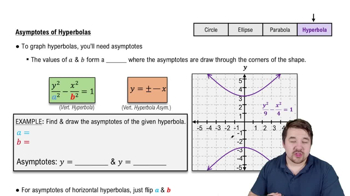A calculator has a built-in sinh⁻¹ x function, but no csch⁻¹ x function. How do you evaluate csch⁻¹ 5 on such a calculator?
Table of contents
- 0. Functions7h 54m
- Introduction to Functions16m
- Piecewise Functions10m
- Properties of Functions9m
- Common Functions1h 8m
- Transformations5m
- Combining Functions27m
- Exponent rules32m
- Exponential Functions28m
- Logarithmic Functions24m
- Properties of Logarithms36m
- Exponential & Logarithmic Equations35m
- Introduction to Trigonometric Functions38m
- Graphs of Trigonometric Functions44m
- Trigonometric Identities47m
- Inverse Trigonometric Functions48m
- 1. Limits and Continuity2h 2m
- 2. Intro to Derivatives1h 33m
- 3. Techniques of Differentiation3h 18m
- 4. Applications of Derivatives2h 38m
- 5. Graphical Applications of Derivatives6h 2m
- 6. Derivatives of Inverse, Exponential, & Logarithmic Functions2h 37m
- 7. Antiderivatives & Indefinite Integrals1h 26m
- 8. Definite Integrals4h 44m
- 9. Graphical Applications of Integrals2h 27m
- 10. Physics Applications of Integrals 3h 16m
- 11. Integrals of Inverse, Exponential, & Logarithmic Functions2h 34m
- 12. Techniques of Integration7h 41m
- 13. Intro to Differential Equations2h 55m
- 14. Sequences & Series5h 36m
- 15. Power Series2h 19m
- 16. Parametric Equations & Polar Coordinates7h 58m
6. Derivatives of Inverse, Exponential, & Logarithmic Functions
Derivatives of Exponential & Logarithmic Functions
Problem 7.3.6
Textbook Question
What is the domain of sech⁻¹ x? How is sech⁻¹ x defined in terms of the inverse hyperbolic cosine?
 Verified step by step guidance
Verified step by step guidance1
Step 1: Recall the definition of the hyperbolic secant function, sech(x), which is given by sech(x) = 1 / cosh(x), where cosh(x) is the hyperbolic cosine function.
Step 2: Understand that the inverse hyperbolic secant function, sech⁻¹(x), is defined for values of x within the domain of the hyperbolic secant function. Since sech(x) outputs values in the range (0, 1], the domain of sech⁻¹(x) is x ∈ (0, 1].
Step 3: Recognize that sech⁻¹(x) can be expressed in terms of the inverse hyperbolic cosine function, cosh⁻¹(x). Specifically, sech⁻¹(x) = cosh⁻¹(1/x), where 1/x must be greater than or equal to 1 to ensure the argument of cosh⁻¹ is valid.
Step 4: Verify that the domain of sech⁻¹(x) aligns with the range of sech(x). Since sech(x) is defined for all real numbers and outputs values in (0, 1], the domain of sech⁻¹(x) is restricted to x ∈ (0, 1].
Step 5: Conclude that the domain of sech⁻¹(x) is x ∈ (0, 1], and it is defined in terms of the inverse hyperbolic cosine as sech⁻¹(x) = cosh⁻¹(1/x).
 Verified video answer for a similar problem:
Verified video answer for a similar problem:This video solution was recommended by our tutors as helpful for the problem above
Video duration:
3mPlay a video:
Was this helpful?
Key Concepts
Here are the essential concepts you must grasp in order to answer the question correctly.
Domain of a Function
The domain of a function refers to the set of all possible input values (x-values) for which the function is defined. For the inverse hyperbolic secant function, sech⁻¹ x, it is essential to determine the values of x that yield valid outputs. Understanding the domain helps in identifying the range of the function and ensures that calculations are performed within valid limits.
Recommended video:

Finding the Domain and Range of a Graph
Inverse Hyperbolic Functions
Inverse hyperbolic functions are the inverses of hyperbolic functions, similar to how inverse trigonometric functions relate to trigonometric functions. The function sech⁻¹ x is defined as the inverse of the hyperbolic secant function, which is related to the hyperbolic cosine. This relationship allows us to express sech⁻¹ x in terms of the inverse hyperbolic cosine, specifically as sech⁻¹ x = cosh⁻¹(1/x) for x in the appropriate domain.
Recommended video:

Asymptotes of Hyperbolas
Hyperbolic Functions
Hyperbolic functions, such as sinh, cosh, and sech, are analogs of trigonometric functions but are based on hyperbolas rather than circles. The hyperbolic secant function, sech(x), is defined as 1/cosh(x), where cosh(x) is the hyperbolic cosine. Understanding these functions is crucial for grasping the properties and definitions of their inverses, including sech⁻¹ x, and how they relate to real numbers and their geometric interpretations.
Recommended video:

Asymptotes of Hyperbolas

 4:50m
4:50mWatch next
Master Derivatives of General Exponential Functions with a bite sized video explanation from Patrick
Start learningRelated Videos
Related Practice
Textbook Question
15
views
